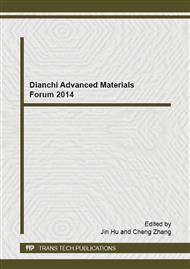p.97
p.102
p.107
p.113
p.118
p.122
p.127
p.132
p.136
Effect of Different CaF2 Powder on Micromechanism and Dissolution Rates of CaF2 Block
Abstract:
CaF2 could be used as inner protection liner material of the cavity which is chemical etched by H2O and HF. This is because CaF2 is not easy deliquescence, corrosion resistance and self-lubricating properties. This paper mainly analysis and research the three kinds of powder form different manufacture factory. The powder is burned in the air at 1360°C for 0.5h, the result display that the density of block we get after a powder is burned is the biggest and the width of the peak gets narrow after were calcined, which indicates the crystallinity has improved. The powder did not react with water at 90°C,but the powder was burned react with water at 90°C。
Info:
Periodical:
Pages:
118-121
Citation:
Online since:
November 2014
Authors:
Keywords:
Price:
Сopyright:
© 2014 Trans Tech Publications Ltd. All Rights Reserved
Share:
Citation:


